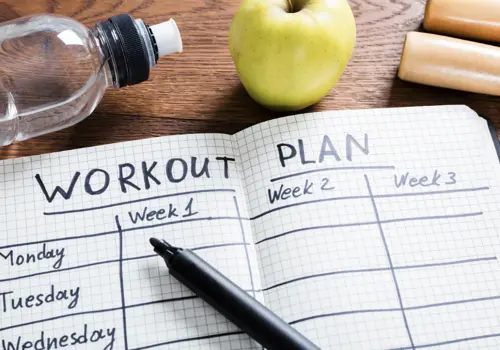Lifestyle • Nov 06, 2024
Understanding Ketosis: When Does It Begin During Fasting?
When Does Ketosis Start When Fasting?
The primary goal of fasting, particularly intermittent fasting, is to restrict food intake to encourage your body to turn to fat for energy instead of glucose. This metabolic state, called ketosis, causes your body to burn fat for energy, producing ketones that replace glucose for energy.
It’s a staple of intermittent fasting, helping participants shed pounds faster by pushing them over the threshold to blaze through fat instead of glucose stores.
But when does ketosis start during fasting? For some, it might only take 12 hours to reach that point, but for others, it may take several days to burn through glucose stores and reach ketosis. It all depends on you and your body.
What is Ketosis?
Ketosis is a metabolic state in which your body uses ketones, produced by burning fat, for energy instead of glucose. It’s a powerful tool for many trying to lose weight, as it can accelerate the fat-burning process and help shed those extra pounds.
How Do You Reach Ketosis?
Reaching ketosis requires depleted glucose stores, but before we explore that, we need to understand the basics of a regular diet without fasting.
When you’re eating on a normal schedule without fasting, your body uses glucose or blood sugar for energy. These sugars are found in carbohydrates you consume throughout the day, including starches and sugars.
After consuming carbs, your body breaks them down into glucose, eventually using the glucose for fuel. Anything you don’t need is stored in your liver for use at a later time.
When you limit your carbohydrate intake, your glucose stores begin to run low. If your body doesn’t have enough glucose to keep you energized, it turns to alternative sources: fat. Without glucose, your body begins to break down fat.
During the fat breakdown process, your liver produces a chemical compound called ketones or ketone bodies. These step into the empty shoes glucose left behind, serving as your body’s main energy source.
This is called ketosis. To reach it, your glucose stores must dip low enough that your body turns to stored fat for energy.
What Does Ketosis Do?
You might’ve heard of different types of fasting, like intermittent fasting, designed to help preserve that state of ketosis for longer periods. But why do people do it? For many people who do it, the goal is to lose weight.
In ketosis, your body turns to stored fat for energy instead of relying on glucose to keep you energized throughout the day. By breaking down stored fat within the body, you create ketones, which your body can then use for energy.
This can help you shed fat, thus helping you reach your weight loss goals.
How Long Does It Take for Ketosis to Start When Fasting?
Everybody is different, but it’s possible to reach ketosis in just 12 hours of fasting. Your body may naturally reach ketosis each night, especially if you go 12 or more hours between dinner and breakfast. Then, in the morning, when you eat your first meal of the day, you break your fast (hence the name breakfast), breaking the state of ketosis.
For some, the process may take longer. It may take several days of a low-carb diet and fasting to reach ketosis. It all depends on your current glucose stores and how long it takes your body to burn through them and turn to stored fat for energy.
Factors That Affect Ketosis
The timeline to reaching ketosis varies from person to person, and once you get there, the effort it takes to preserve that state can vary. A few factors that can affect your ability to reach and maintain ketosis include:
Carb Intake
Your carbohydrate intake is the biggest factor affecting ketosis, considering that your body typically relies on glucose from carbs for energy. If you consume too many carbs, you’ll replenish your glucose stores enough that your body returns to glucose for energy rather than using fat.
So, to achieve and maintain ketosis, you’ll need to restrict your carb intake. For most people, this is less than 50 grams per day, although a more restrictive intake may be necessary for some. The fewer carbs you consume, the faster and more deeply your body can enter ketosis.
Activity Level
Your activity level is another contributing factor. When you exercise, your body uses glycogen (stored glucose) in your muscles for energy. This can help your body enter ketosis more rapidly. High-intensity exercises, such as weightlifting or sprinting, burn through your glycogen much faster, making that switch to ketosis much easier.
Aside from that, staying active can improve insulin sensitivity and enhance fat oxidation, both of which can assist in promoting and maintaining ketosis.
Age
As you age, your metabolic function naturally changes. This can impact your ability to enter and maintain ketosis. Generally, the metabolism slows and muscle mass drops with age, which can impact how your body processes energy and fat.
Older people may find that they need more time to adapt to ketosis, whereas a younger person might have an easier time achieving and maintaining ketosis.
Metabolism
Your metabolism plays a big role in how fast you can achieve ketosis. If you have a quicker metabolism, you may enter ketosis sooner, as your body is likely to burn through glycogen stores faster.
On the flip side, if you have a slower metabolism, it might take you longer. You may also need to be stricter in your adherence to low-carb limits and give yourself a longer period of adaptation before you can fully achieve ketosis.
Certain metabolic conditions, such as insulin resistance and thyroid disorders, can also influence your body’s ability to switch to fat as a fuel source. If you have a metabolic condition, remember to talk to your doctor before attempting to achieve ketosis through fasting.
Ketosis and Fasting: In a Nutshell
Ketosis plays a big role in fasting. It’s the shift from your normal metabolic state, where you burn glucose for energy, to a ketogenic state, where your body uses ketones from burned fat for energy. The timeline to achieving ketosis varies, often taking between 12 hours and a few days to enter the state.
If you’re considering intermittent fasting to help you reach your fitness goals, remember to chat with your doctor. They can help you determine what intermittent fasting eating window is best for you and your needs.
And if you’re ready to take your weight loss journey to the next level, consider adding workouts to the mix. Physical activity can greatly accentuate your progress, helping you reach your goals faster than dieting or fasting alone. Our certified personal trainers can craft a fitness plan curated to your training preferences and fitness level, ensuring you can maximize your progress with a well-rounded diet and fitness plan.
Frequently Asked Questions (FAQs)
When Does Ketosis Start When Fasting?
Ketosis starts when your body turns to fat stores for energy due to depleted glucose stores. This usually happens anywhere between 12 and 72 hours into your fast, although the exact timeframe can look different for each person.
How Long Does it Take to Reach Ketosis When Fasting?
You may enter ketosis after just 12 hours of fasting, although it can take up to 72 hours before you enter this metabolic state. Everybody is different, so the timeline to achieving ketosis can vary from one person to the next.
How Do I Know If I’m in Ketosis?
When your body enters ketosis, you may notice multiple signs. The most notable sign is the presence of ketones in the blood, but since you won’t be able to tell without a blood test, it’s not easily discernible. Physical signs may include weight loss, thirst, or changes in sleep.




